
JATO is a type of assisted take-off for helping overloaded aircraft into the air by providing additional thrust in the form of small rockets. The term JATO is used interchangeably with the term RATO, for rocket-assisted take-off.

The Namib is a coastal desert in Southern Africa. According to the broadest definition, the Namib stretches for more than 2,000 kilometres (1,200 mi) along the Atlantic coasts of Angola, Namibia, and northwest South Africa, extending southward from the Carunjamba River in Angola, through Namibia and to the Olifants River in Western Cape, South Africa. The Namib's northernmost portion, which extends 450 kilometres (280 mi) from the Angola-Namibia border, is known as Moçâmedes Desert, while its southern portion approaches the neighboring Kalahari Desert. From the Atlantic coast eastward, the Namib gradually ascends in elevation, reaching up to 200 kilometres (120 mi) inland to the foot of the Great Escarpment. Annual precipitation ranges from 2 millimetres (0.079 in) in the aridest regions to 200 millimetres (7.9 in) at the escarpment, making the Namib the only true desert in southern Africa. Having endured arid or semi-arid conditions for roughly 55–80 million years, the Namib may be the oldest desert in the world and contains some of the world's driest regions, with only western South America's Atacama Desert to challenge it for age and aridity benchmarks.

The Eustachian tube, also called the auditory tube or pharyngotympanic tube, is a tube that links the nasopharynx to the middle ear, of which it is also a part. In adult humans, the Eustachian tube is approximately 35 mm (1.4 in) long and 3 mm (0.12 in) in diameter. It is named after the sixteenth-century Italian anatomist Bartolomeo Eustachi.

Clifton Curtis Williams Jr., was an American naval aviator, test pilot, mechanical engineer, major in the United States Marine Corps, and NASA astronaut, who was killed in a plane crash; he never went into space. The crash was caused by a mechanical failure in a NASA T-38 jet trainer, which he was piloting to visit his parents in Mobile, Alabama. The failure caused the flight controls to stop responding, and although he activated the ejection seat, it did not save him. He was the fourth astronaut from NASA's Astronaut Group 3 to have died, the first two having been killed in separate T-38 flights, and the third in the Apollo 1 fire earlier that year. The aircraft crashed in Florida near Tallahassee within an hour of departing Patrick AFB.

Soil liquefaction occurs when a cohesionless saturated or partially saturated soil substantially loses strength and stiffness in response to an applied stress such as shaking during an earthquake or other sudden change in stress condition, in which material that is ordinarily a solid behaves like a liquid. In soil mechanics, the term "liquefied" was first used by Allen Hazen in reference to the 1918 failure of the Calaveras Dam in California. He described the mechanism of flow liquefaction of the embankment dam as:
If the pressure of the water in the pores is great enough to carry all the load, it will have the effect of holding the particles apart and of producing a condition that is practically equivalent to that of quicksand... the initial movement of some part of the material might result in accumulating pressure, first on one point, and then on another, successively, as the early points of concentration were liquefied.

Soil mechanics is a branch of soil physics and applied mechanics that describes the behavior of soils. It differs from fluid mechanics and solid mechanics in the sense that soils consist of a heterogeneous mixture of fluids and particles but soil may also contain organic solids and other matter. Along with rock mechanics, soil mechanics provides the theoretical basis for analysis in geotechnical engineering, a subdiscipline of civil engineering, and engineering geology, a subdiscipline of geology. Soil mechanics is used to analyze the deformations of and flow of fluids within natural and man-made structures that are supported on or made of soil, or structures that are buried in soils. Example applications are building and bridge foundations, retaining walls, dams, and buried pipeline systems. Principles of soil mechanics are also used in related disciplines such as geophysical engineering, coastal engineering, agricultural engineering, hydrology and soil physics.
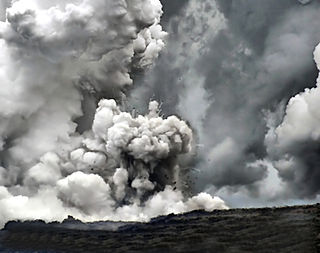
A steam explosion is an explosion caused by violent boiling or flashing of water or ice into steam, occurring when water or ice is either superheated, rapidly heated by fine hot debris produced within it, or heated by the interaction of molten metals. Pressure vessels, such as pressurized water (nuclear) reactors, that operate above atmospheric pressure can also provide the conditions for a steam explosion. The water changes from a solid or liquid to a gas with extreme speed, increasing dramatically in volume. A steam explosion sprays steam and boiling-hot water and the hot medium that heated it in all directions, creating a danger of scalding and burning.
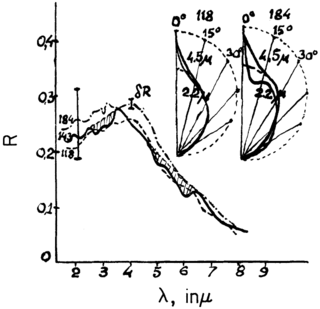
Lunar water is water that is present on the Moon. Diffuse water molecules in low concentrations can persist at the Moon's sunlit surface, as discovered by the SOFIA observatory in 2020. Gradually, water vapor is decomposed by sunlight, leaving hydrogen and oxygen lost to outer space. Scientists have found water ice in the cold, permanently shadowed craters at the Moon's poles. Water molecules are also present in the extremely thin lunar atmosphere.

Theodore Cordy "Ted" Freeman, was an American aeronautical engineer, U.S. Air Force officer, test pilot, and NASA astronaut. Selected in the third group of NASA astronauts in 1963, he was killed a year later in the crash of a T-38 jet, marking the first fatality among the NASA Astronaut Corps. At the time of his death, he held the rank of captain.

Farouk El-Baz is an Egyptian American space scientist and geologist, who worked with NASA in the scientific exploration of the Moon and the planning of the Apollo program. He was a leading geologist on the program, responsible for studying the geology of the Moon, the selection of landing sites for the Apollo missions, and the training of astronauts in lunar observations and photography. He played a key role in the Apollo 11 Moon landing mission, and later Apollo missions. He also came up with the idea of touchable Moon rocks at a museum, inspired by his childhood pilgrimage to Mecca where he touched the Black Stone.
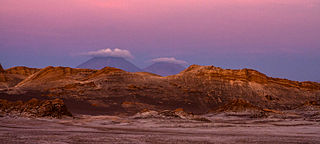
El Valle de la Luna is located 13 kilometres (8 mi) west of San Pedro de Atacama, in the north of Chile in the Cordillera de la Sal, in the Atacama desert. It has various stone and sand formations which have been carved by wind and water. It has an impressive range of color and texture, looking somewhat similar to the surface of the Moon. There are also dry lakes where the composition of salt makes a white covering layer of the area. It presents diverse saline outcrops which appear like man-made sculptures. There are also a great variety of caverns. When the sun sinks it defines the landscape while the wind blows among the rocks and the sky passes from pink color to purple and finally black. Valle de la Luna is a part of the Reserva Nacional los Flamencos and was declared a Nature Sanctuary in 1982 for its natural environment and strange lunar landscape, from which its name is derived. The Atacama desert is also considered one of the driest places on earth, as some areas have not received a single drop of rain in hundreds of years. A prototype for a Mars rover was tested there by scientists because of the valley's dry and forbidding terrains.
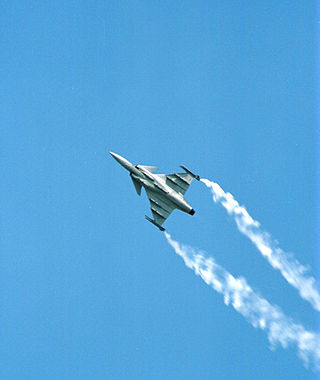
The JAS 39 Gripen is a fighter aircraft manufactured by the Swedish aerospace company Saab.
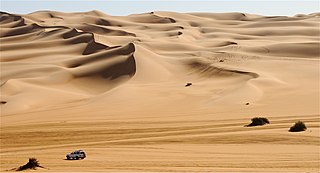
A desert is a landscape where little precipitation occurs and, consequently, living conditions create unique biomes and ecosystems. The lack of vegetation exposes the unprotected surface of the ground to denudation. About one-third of the land surface of the Earth is arid or semi-arid. This includes much of the polar regions, where little precipitation occurs, and which are sometimes called polar deserts or "cold deserts". Deserts can be classified by the amount of precipitation that falls, by the temperature that prevails, by the causes of desertification or by their geographical location.

Sand is a granular material composed of finely divided mineral particles. Sand has various compositions but is defined by its grain size. Sand grains are smaller than gravel and coarser than silt. Sand can also refer to a textural class of soil or soil type; i.e., a soil containing more than 85 percent sand-sized particles by mass.
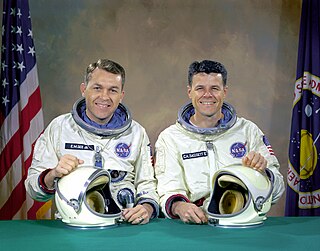
The 1966 NASA T-38 crash occurred when a NASA Northrop T-38 Talon crashed at Lambert Field in St. Louis, Missouri, on February 28, 1966, killing two Project Gemini astronauts, Elliot See and Charles Bassett. The aircraft, piloted by See, crashed into the McDonnell Aircraft building where their Gemini 9 spacecraft was being assembled. The weather was poor with rain, snow, fog, and low clouds. A NASA panel, headed by the Chief of the Astronaut Office, Alan Shepard, investigated the crash. While the panel considered possible medical issues or aircraft maintenance problems, in addition to the weather and air traffic control factors, the end verdict was that the crash was caused by pilot error.

Reynolds is an impact crater on Mars, located in the Mare Australe quadrangle at 75.1°S latitude and 157.9°W longitude and is in the southernmost portion of Terra Sirenum. It measures 91 kilometers in diameter and was named after British physicist Osborne Reynolds.















